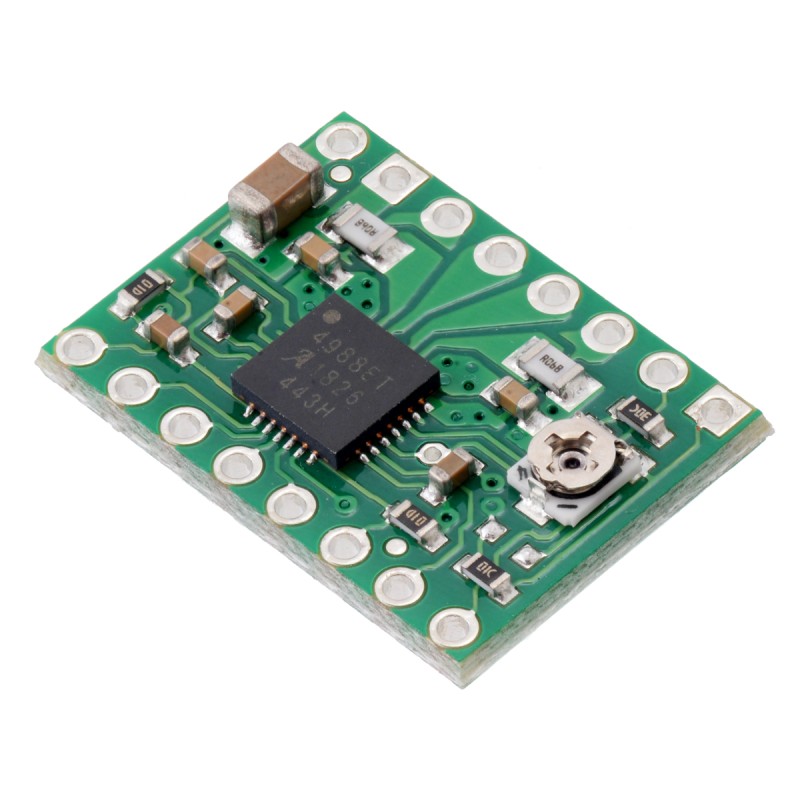

A4988 Stepper Motor Driver Carrier
The A4988 stepper motor driver carrier is a breakout board for Allegro’s easy-to-use A4988 microstepping bipolar stepper motor driver and is a drop-in replacement for the A4983 stepper motor driver carrier. The driver features adjustable current limiting, overcurrent protection, and five different microstep resolutions. It operates from 8 – 35 V and can deliver up to 2 A per coil.
Limited stock until mid-August: We are limiting immediate shipments to five (5) units per order until our supply of these units improves. Orders for larger quantities will be accepted but put on backorder.
Limited stock until mid-August: We are limiting immediate shipments to five (5) units per order until our supply of these units improves. Orders for larger quantities will be accepted but put on backorder.
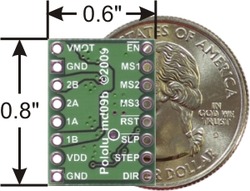 |
| A4983/A4988 stepper motor driver carrier with dimensions. |
|---|
This product is a carrier board or breakout board for Allegro’s A4988 DMOS Microstepping Driver with Translator and Overcurrent Protection; we therefore recommend careful reading of the A4988 datasheet (380k pdf) before using this product. This stepper motor driver lets you control one bipolar stepper motor at up to 2 A output current per coil (see the Power Dissipation Considerations section below for more information). Here are some of the driver’s key features:
Like nearly all our other carrier boards, this product ships with all surface-mount components—including the A4988 driver IC—installed as shown in the product picture.
We also sell a larger version of the A4988 carrier that has reverse power protection on the main power input and built-in 5 V and 3.3 V voltage regulators that eliminate the need for separate logic and motor supplies.
Some unipolar stepper motors (e.g. those with six or eight leads) can be controlled by this driver as bipolar stepper motors. For more information, please see the frequently asked questions. Unipolar motors with five leads cannot be used with this driver.
The A4988 stepper motor driver carrier comes with one 1?16-pin breakaway 0.1" male header. The headers can be soldered in for use with solderless breadboards or 0.1" female connectors. You can also solder your motor leads and other connections directly to the board.
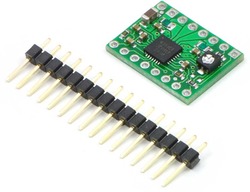 |
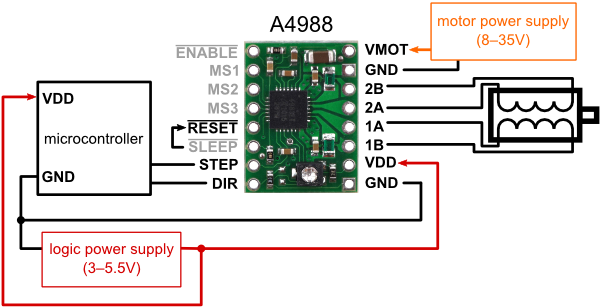 |
| Minimal wiring diagram for connecting a microcontroller to an A4988 stepper motor driver carrier (full-step mode). |
|---|
The driver requires a logic supply voltage (3 – 5.5 V) to be connected across the VDD and GND pins and a motor supply voltage of (8 – 35 V) to be connected across VMOT and GND. These supplies should have appropriate decoupling capacitors close to the board, and they should be capable of delivering the expected currents (peaks up to 4 A for the motor supply).
Warning: This carrier board uses low-ESR ceramic capacitors, which makes it susceptible to destructive LC voltage spikes, especially when using power leads longer than a few inches. Under the right conditions, these spikes can exceed the 35 V maximum voltage rating for the A4988 and permanently damage the board, even when the motor supply voltage is as low as 12 V. One way to protect the driver from such spikes is to put a large (> 50 µF) electrolytic capacitor across motor power (VMOT) and ground somewhere close to the board.
Four, six, and eight-wire stepper motors can be driven by the A4988 if they are properly connected; a FAQ answer explains the proper wirings in detail.
Warning: Connecting or disconnecting a stepper motor while the driver is powered can destroy the driver. (More generally, rewiring anything while it is powered is asking for trouble.)
Stepper motors typically have a step size specification (e.g. 1.8° or 200 steps per revolution), which applies to full steps. A microstepping driver such as the A4988 allows higher resolutions by allowing intermediate step locations, which are achieved by energizing the coils with intermediate current levels. For instance, driving a motor in quarter-step mode will give the 200-step-per-revolution motor 800 microsteps per revolution by using four different current levels.
The resolution (step size) selector inputs (MS1, MS2, MS3) enable selection from the five step resolutions according to the table below. MS1 and MS3 have internal 100kΩ pull-down resistors and MS2 has an internal 50kΩ pull-down resistor, so leaving these three microstep selection pins disconnected results in full-step mode. For the microstep modes to function correctly, the current limit must be set low enough (see below) so that current limiting gets engaged. Otherwise, the intermediate current levels will not be correctly maintained, and the motor will effectively operate in a full-step mode.
| MS1 | MS2 | MS3 | Microstep Resolution |
|---|---|---|---|
| Low | Low | Low | Full step |
| High | Low | Low | Half step |
| Low | High | Low | Quarter step |
| High | High | Low | Eighth step |
| High | High | High | Sixteenth step |
Each pulse to the STEP input corresponds to one microstep of the stepper motor in the direction selected by the DIR pin. Note that the STEP and DIR pins are not pulled to any particular voltage internally, so you should not leave either of these pins floating in your application. If you just want rotation in a single direction, you can tie DIR directly to VCC or GND. The chip has three different inputs for controlling its many power states: RST, SLP, and EN. For details about these power states, see the datasheet. Please note that the RST pin is floating; if you are not using the pin, you can connect it to the adjacent SLP pin on the PCB.
To achieve high step rates, the motor supply is typically much higher than would be permissible without active current limiting. For instance, a typical stepper motor might have a maximum current rating of 1 A with a 5Ω coil resistance, which would indicate a maximum motor supply of 5 V. Using such a motor with 12 V would allow higher step rates, but the current must actively be limited to under 1 A to prevent damage to the motor.
The A4988 supports such active current limiting, and the trimmer potentiometer on the board can be used to set the current limit. One way to set the current limit is to put the driver into full-step mode and to measure the current running through a single motor coil without clocking the STEP input. The measured current will be 0.7 times the current limit (since both coils are always on and limited to 70% in full-step mode). Please note that the current limit is dependent on the Vdd voltage.
Another way to set the current limit is to measure the voltage on the “ref” pin and to calculate the resulting current limit (the current sense resistors are 0.05Ω). The ref pin voltage is accessible on a via that is circled on the bottom silkscreen of the circuit board. See the A4988 datasheet for more information.
The A4988 driver IC has a maximum current rating of 2 A per coil, but the actual current you can deliver depends on how well you can keep the IC cool. The carrier’s printed circuit board is designed to draw heat out of the IC, but to supply more than approximately 1 A per coil, a heat sink or other cooling method is required.
This product can get hot enough to burn you long before the chip overheats. Take care when handling this product and other components connected to it.
Please note that measuring the current draw at the power supply does not necessarily provide an accurate measure of the coil current. Since the input voltage to the driver can be significantly higher than the coil voltage, the measured current on the power supply can be quite a bit lower than the coil current (the driver and coil basically act like a switching step-down power supply). Also, if the supply voltage is very high compared to what the motor needs to achieve the set current, the duty cycle will be very low, which also leads to significant differences between average and RMS currents.
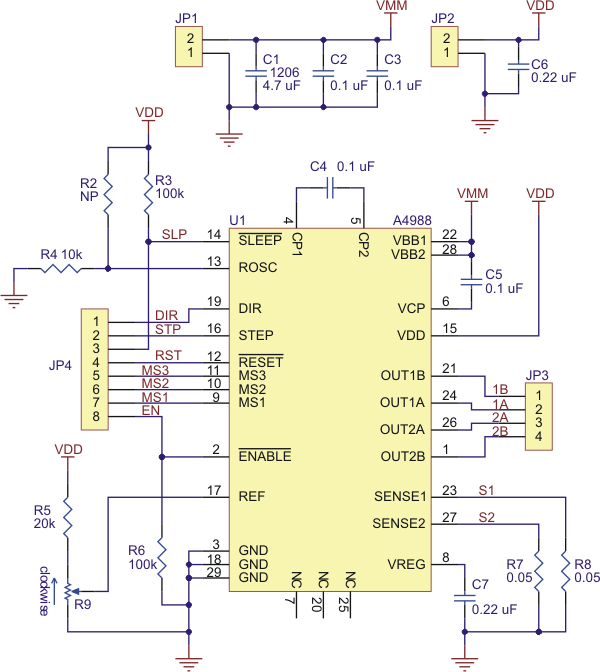 |
| Schematic diagram of the md09b A4988 stepper motor driver carrier. |
|---|
Note: This board is a drop-in replacement for our original A4983 stepper motor driver carrier. The newer A4988 offers overcurrent protection and has an internal 100k pull-down on the MS1 microstep selection pin, but it is otherwise virtually identical to the A4983.
Cechy
Producent BTC Korporacja sp. z o. o. Lwowska 5 05-120 Legionowo Polska sprzedaz@kamami.pl 22 767 36 20
Osoba odpowiedzialna BTC Korporacja sp. z o. o. Lwowska 5 05-120 Legionowo Polska sprzedaz@kamami.pl 22 767 36 20
Bipolarny silnik krokowy. Ma rozdzielczość 200 kroków/obrót (1.8° na krok), napięcie znamionowe 7,4 V i pobiera prąd o natężeniu 0,28 A na cewkę. Pololu 1207
Bipolarny silnik krokowy. Ma rozdzielczość 200 kroków/obrót (1.8° na krok), napięcie znamionowe 10 V i pobiera prąd o natężeniu 0,5 A na cewkę. Pololu 1208
Bipolarny silnik krokowy. Ma rozdzielczość 200 kroków/obrót (1.8° na krok), napięcie znamionowe 3,9 V i pobiera prąd o natężeniu 0,6 A na cewkę. Pololu 1204
Bipolarny silnik krokowy. Ma rozdzielczość 200 kroków/obrót (1.8° na krok), napięcie znamionowe 3,8 V i pobiera prąd o natężeniu 0,67 A na cewkę. Pololu 1205
Bipolarny silnik krokowy. Ma rozdzielczość 200 kroków/obrót (1.8° na krok), napięcie znamionowe 4,5 V i pobiera prąd o natężeniu 0,67 A na cewkę. Pololu 1206
Brak towaru
Bipolarny silnik krokowy. Ma rozdzielczość 200 kroków/obrót (1.8° na krok), napięcie znamionowe 2,7 V i pobiera prąd o natężeniu 1 A na cewkę. Pololu 1209
Brak towaru
Unipolarny/bipolarny silnik krokowy. Ma rozdzielczość 200 kroków/obrót (1.8° na krok), napięcie znamionowe 4 V i pobiera prąd o natężeniu 1,2 A na cewkę. Pololu 1200
Bipolarny silnik krokowy. Ma rozdzielczość 200 kroków/obrót (1.8° na krok), napięcie znamionowe 4,5 V i pobiera prąd o natężeniu 1 A na cewkę. Pololu 2297
Brak towaru
Bipolarny silnik krokowy zasilany napięciem do 12 V, pobiera prąd do 400 mA. SparkFun ROB-10551
Sterownik silnika krokowego z układem Allegro A4988 (A4988 Stepper Motor Driver Carrier) pozwala na zasilanie silnika bipolarnego prądem do 2A na fazę. Układ może być zasilany napięciem do 35V, w zestawie znajduje się radiator. Jest kompatybilny z Pololu 1182
DRV8825 Stepper Motor Driver Carrier to sterownik silnika krokowego z układem A4988, pozwala na zasilanie silnika bipolarnego prądem do 1,2 A na fazę, bez użycia radiatora. Układ może być zasilany napięciem do 35 V. Pololu 2980
Moduł ze sterownikiem silnika krokowego oparty na układzie DRV8434A. Pozwala na zasilanie silnika bipolarnego prądem do 1,2 A na fazę i napięciem od 4,5 V do 45 V. Komunikacja przez interfejs SPI. Pololu 3766
Brak towaru
Jednokanałowy sterownik silników DC z interfejsem UART TTL. Jest zasilany napięciem od 4,5 V do 48 V i może dostarczyć prąd o natężeniu do 2,2 A. Płytka z przylutowanymi złączami. Pololu 5062
Brak towaru
2x1.2A DC Motor Driver to podwójny sterownik silników DC zasilanych napięciem 2,5-12V o maksymalnym poborze prądu 1,2A (3,2A w szczycie) na kanał. DFRobot DRI0044
Miniaturowy sterownik typu ESC do silnika DC o napięciu zasilania od 3,7 V do 5 V. Oferuje maksymalny prąd wyjściowy do 1,5 A i pozwala na sterowanie dwoma silnikami w trybie miksowania kanałów
Sterownik silnika krokowego oparty na układzie TB67S249FTG. Pozwala sterować silnikiem krokowym napięciem od 10 do 47V, z maksymalnym natężeniem prądu do 1,8A. Sterownikiem można sterować przy pomocy: USB, Serial TTL, I2C, RC (PWM modelarski), wejście analogowe czy enkoder kwadraturowy. Pololu 3138
Kontroler prędkości oparty na otwartym standardzie VESC, przeznaczony do deskorolek, hulajnóg i rowerów elektrycznych. Obsługuje napięcie od 14 do 75 V i prąd ciągły do 100 A, oferując różne tryby sterowania silnikami BLDC oraz szeroki wybór interfejsów (PPM, UART, I2C, USB-C, CAN). Dzięki kompaktowej konstrukcji i rozbudowanym zabezpieczeniom zapewnia niezawodność, elastyczną konfigurację oraz wygodną integrację z komputerem i smartfonem. Makerbase VESC 75100
Brak towaru
Dwukanałowy sterownik silników DC o napięciu pracy od 7 do 35 V i prądzie ciągłym do 10 A. Może być sterowany sygnałem analogowym, PWM, UART, RC lub za pomocą wbudowanych przycisków. Cytron MDDS10
Pololu High-Power Motor Driver 18v15
Brak towaru
Moduł sterownika silników DC z dwoma kanałami, dedykowany do stosowania w modelarstwie. Może być sterowany za pomocą nadajnika RC i wykorzystuje sygnał PPM. DFRobot DFR0513
Sterownik silników DC, który pozwala na kontrolowanie ruchu dwóch napędów za pomocą interfejsu I2C. Płytka z przylutowanymi złączami. Pololu 5042
Brak towaru
Moduł ze sterownikiem silników TB6612FNG oraz sterownikiem PWM PCA9685 dla Raspberry Pi Pico. Pozwala na kontrolowanie ruchu 4 silników DC. Waveshare Pico-Motor-Driver
Kompaktowy sterownik, który umożliwia precyzyjne sterowanie bipolarnymi silnikami krokowymi. Oferuje dużą precyzję ruchu dzięki możliwości sterowania silnikiem krokowym z rozdzielczością do 1/128 kroku oraz dwa interfejsy sterujące - sterowanie krokowe typu clock-in oraz komendy szeregowe. SparkFun ROB-25167
Dual MAX14870 Motor Driver to podwójny sterownik silników DC kompatybilny ze standardem Raspberry Pi pozwalający na wysterowanie dwóch silników DC napięciem 4,5-36V prądem ciągłym 1,7A. Pololu 3758
Sterownik silnika krokowego A4988 operujący na napięciach 8..35 V i prądzie 1,2 A. Pololu 2128
Pololu G2 24v21 to miniaturowy sterownik silnika DC. Zasilanie sterownika: 6.5V...40V. Wydajność prądowa modułu: 21A.
Moduł posiada zabezpieczenie przed napięciem wstecznym i przepięciami. Pololu 2995

A4988 Stepper Motor Driver Carrier
